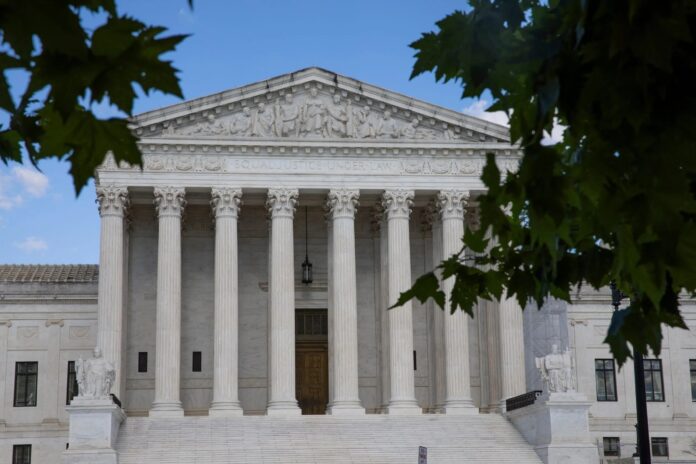Kit Beyer is a researcher and writer at Fix the Court, a nonprofit that advocates for greater transparency and accountability in the federal judiciary.
Please note that SCOTUS Outside Opinions constitute the views of outside contributors and do not necessarily reflect the opinions of SCOTUSblog or its staff.
On the morning of May 15, national attention converged on the Supreme Court as the justices heard Trump v. CASA, Inc., a challenge to President Donald Trump’s executive order restricting birthright citizenship. Any interested person could go to the Supreme Court’s website and hear, promptly and firsthand, the justices’ colloquies with advocates.
Before these high-stakes proceedings began, however, came another noteworthy event: the announcement of the court’s unanimous opinion in Barnes v. Felix. That case concerned a police officer’s use of deadly force, an issue that, like birthright citizenship and many other questions that the court handles each term, evokes broad public attention and debate. We heard the arguments in CASA – but not the decision in Barnes. It’s time to close that gap.
The court began livestreaming oral arguments during the COVID-19 pandemic in 2020 and has continued the practice ever since. The livestreams let Americans learn, in real time, about how the justices are approaching the most pressing legal problems of the day. But when it comes to announcing actual decisions – rulings that instantly affect the application of the law nationwide – only the handful of individuals who are able to make it to the court (and secure one of the few seats available to the public) enjoy immediate access. The rest of us must wait until the start of the next term, when the National Archives releases the recordings of oral opinion summaries delivered from the bench.
This delay is unwarranted. Livestreaming opinion announcements, which are already recorded and accessible to the court’s immediate audience, would offer significant benefits with minimal cost. As it prepares to release decisions in high-profile cases involving tax benefits for religious organizations, age-verification requirements for online sexual material, and parents’ objections to their children being exposed to LGBTQ-themed books in public schools, not to mention CASA, the court should extend its livestreaming policy to include the justices’ delivery of these opinions from the bench, giving the public direct access to some of the most meaningful moments in national civic life.
First, livestreaming opinion announcements would reflect the presumption of openness in legal proceedings. As Don Willett, a federal appeals court judge, wrote in a 2021 opinion, in our republic, “the default expectation is transparency — that what happens in the halls of government happens in public view” – or at least, I might add, in public earshot. A court proceeding is inherently a public affair, and the announcement of judicial opinions to a public audience is all the more so. Stowing the recordings away until the next term contradicts the public-serving function of announcing opinions and wrongly deprives the people of insight into the workings of an immensely powerful governmental institution.
True, the court’s written opinion becomes available on the court’s website right away. But a written text fails to capture the communicative aspects of tone, cadence, and demeanor in a justice’s delivery. Oral argument transcripts are an incomplete substitute for the audio broadcasts; the same is true of opinions. Consider Justice Hugo Black “[t]rembling with rage and shaking his finger at the courtroom audience” while orally dissenting in Brown v. Louisiana, or Justice John Paul Stevens speaking “in a slow, halting voice, periodically getting tangled up in thickets of words like ‘corporation’ and ‘corruption’” during his oral dissent in Citizens United v. FEC. These nonverbal signals matter. They capture the nature of justices’ sentiments in a way that written words do not.
Even the very act of delivering an oral opinion carries symbolic significance. On opinion release days, the author of the majority opinion announces the court’s decision and reads a summary of the ruling, but the justices generally do not read their concurrences or dissents. When a justice does choose to read a separate opinion, it may indicate that the justice considers the case particularly important or believes that the majority has gone seriously astray.
Moreover, oral summaries do not follow the written opinions verbatim. In Miranda v. Arizona, for instance, Chief Justice Earl Warren departed from his prepared text to praise police officers “when their services are honorably performed.” And in Parents Involved in Community Schools v. Seattle School District No. 1, Justice Stephen Breyer’s oral dissent included a biting line that appeared nowhere in his written text: “It is not often in the law that so few have so quickly changed so much.” These unwritten remarks are most relevant at the moment of delivery, as the justice is actively framing a new development in the law.
Requiring the public to hear such statements vicariously, or else months later, does a disservice to both justices and the public. It needlessly hampers judicial transparency with none of the usual concerns over national security or party confidentiality that might justify limiting public access.
Opponents of live-streaming opinion announcements might marshal the same claims once deployed against live-streaming arguments: namely, that it could “adversely affect” the proceedings by changing the justices’ behavior. But years of experience with live-streaming arguments have diminished the force of these speculations, and as things stand, the justices are already announcing their opinions to a room of spectators and media. Live-streaming would only expand the audience; it would be a difference in scope rather than substance.
In The Federalist no. 84, Alexander Hamilton addressed fears that the distance between the national capital and much of the population would inhibit informed public participation. The same problem, Hamilton argued, already existed within each state: the benefit of “personal observation” was “confined to the citizens on the spot” of state capitals, leaving everyone else to “depend on the information of intelligent men, in whom they confide.” Back then, most Americans faced a dichotomous choice: either travel at great expense to the seat of government or settle for secondhand accounts.
Today, we have a third option. Real-time audio broadcasting lets Americans witness governance without the need for an onerous journey to D.C. The highest court in the country should take full advantage of this change. There is no sensible reason to deny we the people the opportunity to listen to what our court has to say to us all.
Posted in Featured, Focus on court reform
Recommended Citation:
Kit Beyer,
The Supreme Court should livestream opinion announcements,
SCOTUSblog (Jun. 3, 2025, 11:26 AM),
https://www.scotusblog.com/2025/06/the-supreme-court-should-livestream-opinion-announcements/





